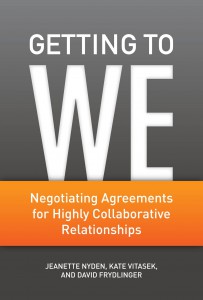 When we talk about the doing the deal, the point is to get the deal done, right? To get to yes in the most advantageous way possible for your company—the deal that best serves your specific interest, at the lowest possible cost. And then you move on to the next deal, right?
When we talk about the doing the deal, the point is to get the deal done, right? To get to yes in the most advantageous way possible for your company—the deal that best serves your specific interest, at the lowest possible cost. And then you move on to the next deal, right?
Wrong!
That mindset is totally old school and inadequate for today’s economic and business realities. A new way of thinking about business relationships is needed, a new paradigm that can take you and your partners beyond the handshake and the initial yes to Getting to We.
Our just-published book, Getting to We by Jeanette Nyden, Kate Vitasek and David Frydlinger, details a game-changing agreement negotiation process based on the application of Vested’s proven “what’s-in-it-for-we” (WIIFWe) business relationship approach.
The WIIFWe mindset is the foundation of a Vested relationship; it is a change in social norms from a what’s-in-it-for-me (WIIFMe) mindset. WIIFWe is the philosophical mantra forming the structure of a collaborative and trusting relationship. Once embraced, a WIIFWe mindset has the power to deliver a competitive advantage for the parties long after a deal is signed.
The Getting to We mindset and process changes the purpose of the negotiation from the deal to the relationship. In other words it has the potential to revolutionize and transform modern business negotiations—because the relationship itself becomes the focus of the parties’ work.
The Getting to We process changes the goal of the negotiation from simply getting the deal done to forging a win-win partnership. Following the Getting to We negotiation methodolgy helps companies change how they view the relationship—helping them embrace the WIIFWe mindset. This is done through an approach based on trust and six additional core principles that flow from true commitment to trust: reciprocity, autonomy, honesty, equity, loyalty and integrity, which I’ll explore in subsequent posts.
Organizations exploring a Vested business model find they can use the Getting to We process to help them create a highly collaborative relationship even if they are unable to follow all five of Vested’s rules. This is because they recognize that collaboration can thrive when they look beyond simply getting the deal done to developing a long-term partnership based on the parties’ commitment to fundamental social norms.
Getting to We’s five-step negotiation process is becoming instrumental in helping companies achieve success as they pursue Vested relationships, the topic for my next blog post.